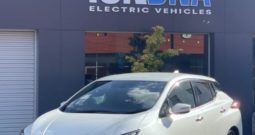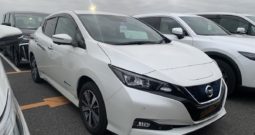When the original ZE0 Nissan Leaf was launched in late 2010, it became the first (current era) mass produced full battery electric vehicle (BEV) to be designed from the ground up. (To that time, the only others were based on petrol cars: the 2010 Mitsubishi iMiEV was based on the petrol i-car, and the only Tesla then available was built using a Lotus Elise body).
Ground-breaking in many ways – the Leaf won a multitude of motoring awards around the world.
Nissan Australia first began selling the ZE0 Leaf here in 2012 – but at $60,000 plus, they did not sell well. As a result many sat quietly in dealer yards for several years before finally selling. Consequently, no more ZE0 Leafs were officially imported here other than 2011/2012 build date models. Australia dealer supported Leafs therefore missed out on the many improvements that occurred later in the ZE0 model run. These included:
2013: AZE0 model update started here
- A move from 3.6kW to an optional 6.6kW battery charger (Note: larger charger generally NOT found in Japanese import Leafs);
- Introduction of a reverse cycle air conditioner to provide heating. (Reverse cycle A/C was much more efficient than the resistive element heater that preceded it);
- much smaller boot hump (= increased boot capacity);
- Improved driving mode options.
- Foot operated handbrake. (Formerly switch on console).
2014/15
- Upgraded battery chemistry that was less prone to heat degradation.
2016:
- Increased battery size (from 24 to 30kWh).
Note: a number of private (or ‘grey’) imports of Japanese model AZE0 Leafs has occurred between Nissan Australia ceasing imports in 2013 and recommencing with the ZE1 Leaf in 2019, including the bulk-buy schemes offered by the GoodCarCompany (https://www.goodcar.co/).
Important note: The biggest issues with private imports are service, warranty and recall support. Privately imported vehicles are generally not supported by the dealer networks who often refuse to work on them, or perform any warranty or recall work that would have been done for free in their country of origin.
Nissan Leaf ZE0 Variants
| Variant | Battery (kWh) | WLTP Range (km) | EPA Range (km) | Power Output (kW) | Maximum Torque (Nm) | Plug Types (AC/DC) | Max Charge Rate (AC/DC) | Price |
|---|---|---|---|---|---|---|---|---|
| Leaf ZE0 | 24 | 170 | 130 | 80 | 290 | Type 1 (AC) CHAdeMO (DC) | 3.6-6.6/46 | $46,990 |
DRIVING RANGE
The 24kWh ZE0 Leaf had a quoted range of around 170km – but in reality it was at best 130km. For Australian delivered 2011/12 Leafs – this is now likely to be, at most, 80km – or even less in winter as their heating system was quite inefficient compared to the later reverse cycle systems.
CHARGING SPEEDS/REQUIREMENTS
Charging port
The ZE0/AZE0 Nissan Leafs were fitted with a Type 1 AC socket and a CHAdeMO DC fast-charge socket. Whilst CHAdeMO is now used only in the current ZE1 Leaf (all other EVs in Australia now use the CCS2 socket), CHAdeMO DC fast-charge plugs are continuing to be installed at most fast-charge stations, which is likely to continue for some years into the future. However ZE0/AZE0 Leaf owners will need a Type 1 to Type 2 adaptor lead (at a cost of around $250) to use most current AC chargers.
AC charging
The ZE0/AZE0 Leaf is fitted with the single phase type 1 AC socket and charges at up to 3.6kW for the ZE0 and up to 6.6kW for some AZE0 models on AC EVSEs (EVSE = Electric Vehicle Supply Equipment, commonly referred to as an EV charger).
General charging note:
Charging speeds vary on the capacity of the car’s inbuilt charger, the EVSE the car is connected to and the vehicle battery size. Charging times for the 3.6kW ZE0 Leaf are shown in the table below. (0-100% for AC, 0-80% for DC)
DC fast charging
ZE0/AZE0 Leafs electric uses the CHAdeMO DC fast-charge connector and have a maximum 46kW charging rate when connected to a DC charger.
Nissan Leaf ZEO Time to Charge (hrs)
| Battery size (kWh) | 10A socket (2.4kW) | 16A 1 phase (3.6kW) | 32A 1 phase (7.2kW) | 16A 3 phase (11kW) | DC Fast Charge (to 80%) |
|---|---|---|---|---|---|
| 24 | 10h | 6.7h | 6.7h | 6.7h | 27min |
HOME CHARGING CONSIDERATIONS
To get the shortest home charging time for a ZE0 Leaf, a 3.6kW AC EVSE is all that is needed. For some AZE0 Leafs, this increases to 6.6kW.
Note:
Depending on your existing power supply and/or charging needs, it may only be necessary (or practicable) to fit a lower rated EVSE. (See notes re
home EVSE installations at the end of this section). Lower capacity EVSEs will increase charging times, as shown in table 1.
Both the ZE0 and AZE0 Leafs came with a Mode 2 EVSE (‘portable charger’) for plugging into a 15A power point.
When buying any second-hand EV, ensure the portable EVSE both comes with the car and is working.
Important note for any home EVSE installation:
Switchboard and/or electrical supply upgrades may be needed if your home is more than 20 years old.
See article ‘Is your home EV Ready’ in ReNew magazine, edition 143.
Nissan Leaf ZEO Specifications
| Cargo space (litres) | Cargo Space with rear seats folded (litres) | Length (mm) | Width (mm) | Width with mirrors (mm) | Height (mm) | Tow Rating (braked / unbraked) |
|---|---|---|---|---|---|---|
| 330 | not specified | 4450 | 1770 | not specified | 1550 |



